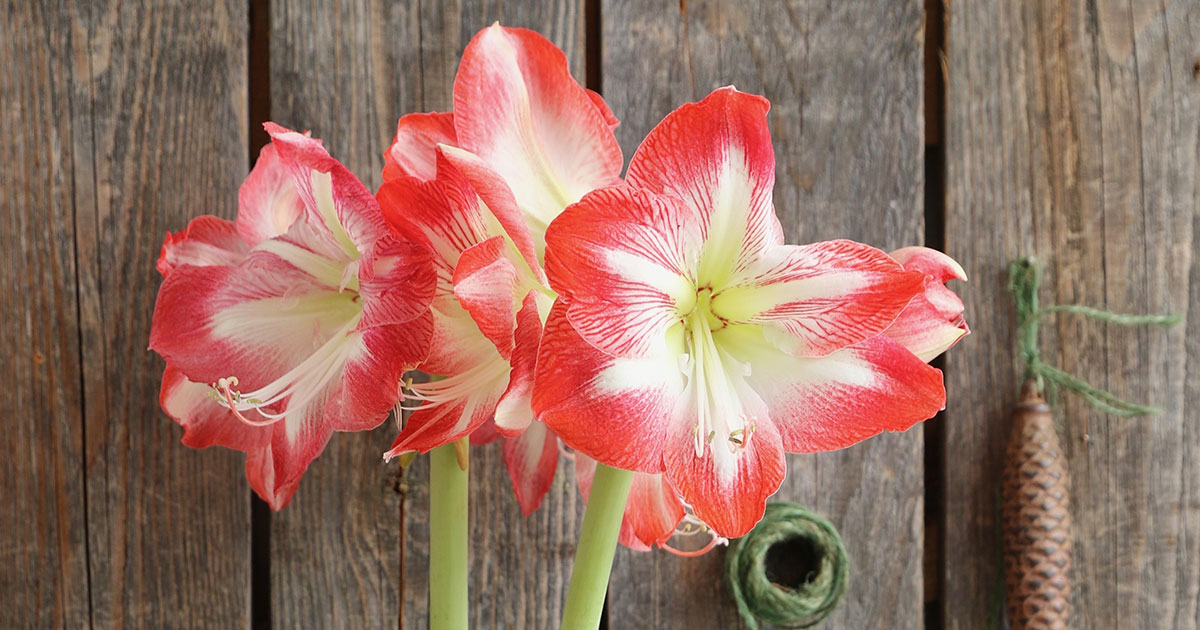Is anything prettier or more dramatic than amaryllis in full bloom? What we call ‘amaryllis’ are really ‘hippeastrum’—members of the amaryllis family.
The plants that are really ‘amaryllis’ are the Amaryllis Belladonna and relatives. These days, however, hippeastrum has been called ‘amaryllis’ for so long, we’ll never be able to get people to call them anything else. So I’ll call them amaryllis, too.
Facts About Amaryllis
The word Hippeastrum comes from the ancient Greek—hippeus (Mounted knight) and astron (star). So Hippeastrum means Knight’s Star. The word Amaryllis, in Greek, means sparkle.
Just about everywhere these days you can find amaryllis in boxes—a red, a white, a pink, and a red-and-white stripe. They’ll be priced in the vicinity of 10 bucks, give or take a dollar. If you need a grab-and-go quick gift, they’re great. But if you are growing something for yourself or family and friends, look for just the bulb and plant it yourself.
Bigger is Better
With amaryllis, the bigger the bulb for the variety, the more flowers you get—hands down. The amaryllis in the gift boxes are about as big as a small apple. In a garden center, you can find individual bulbs of the same variety as big as a grapefruit—or even a little bigger. The small bulb in the box will give you one to two flower stems with three to four flowers on a stem. The bigger bulb can give you two to three stems with four to six flowers each.
Amaryllis come in so many fun varieties—double-flowered amaryllis like Double Dragon and Elvas that are gorgeous and showy; minis like Evergreen and Baby Star that are short and sturdy; odd ones like La Paz that look like a spider; dramatic ones like Black Pearl whose flowers look like burgundy satin or Magic Green with pale green flowers with burgundy streaks.
Amaryllis are Easy to Grow
Amaryllis are easy to grow and bloom—and re-bloom.
When you buy the bulb, plant it in a pot about one to one and a half inches bigger around, leaving the top third of the bulb above the soil level. Water lightly, but keep on the dry side until growth appears. It can take two to three weeks before the tip of a bloom spike shows. Keep in a sunny window. The flower stalks are like “light meters” and will grow pointing to the light, so turn the pot a quarter turn every time you water. More sun will keep the stalk short and sturdy. Most bulbs will have two stems. Both stems may bloom at the same time, but more often, one stalk will bloom and the other a week or so later.
After the Bulb Blooms
After the bulb blooms, it will begin to grow leaves. When you cut the spent flowers off, do not disturb the foliage. This would be the time to begin feeding your amaryllis. I usually use my favorite Neptune’s Harvest fish/seaweed blend but any good houseplant food is fine. I keep the pot in a sunny window until the end of April and then move it outside for the summer. Over the summer, I feed them and keep them watered. If you know you’re going to forget to feed once they are outside, then use a slow-release and that’ll take care of them most of the summer.
Time to go to Sleep
In the middle or end of October, I bring my amaryllis inside and dry them out. I cut the leaves off, leaving a one-inch stubble, and store the dry bulb in the pot in the back of a closet, an attic, basement, or garage—any place cool, dark, and dry.
At the end of eight weeks, I check on them and if I see any fat stiff little bloom shoots showing I bring them out, otherwise I leave them another two weeks. When you bring them out, place them in a sunny window and begin watering and they’ll bloom again. The secret is feeding over the summer and giving them an eight to ten-week dormancy. If you do that, they’ll bloom for you year after year.
Visit the Greenhouse Now for the Best Selection
Come in and check out our selection of this fun and easy bloomer. You’ll feel great and so will everyone you give this beautiful gift to—and don’t forget to give a gift of one to yourself. Who deserves it more?

